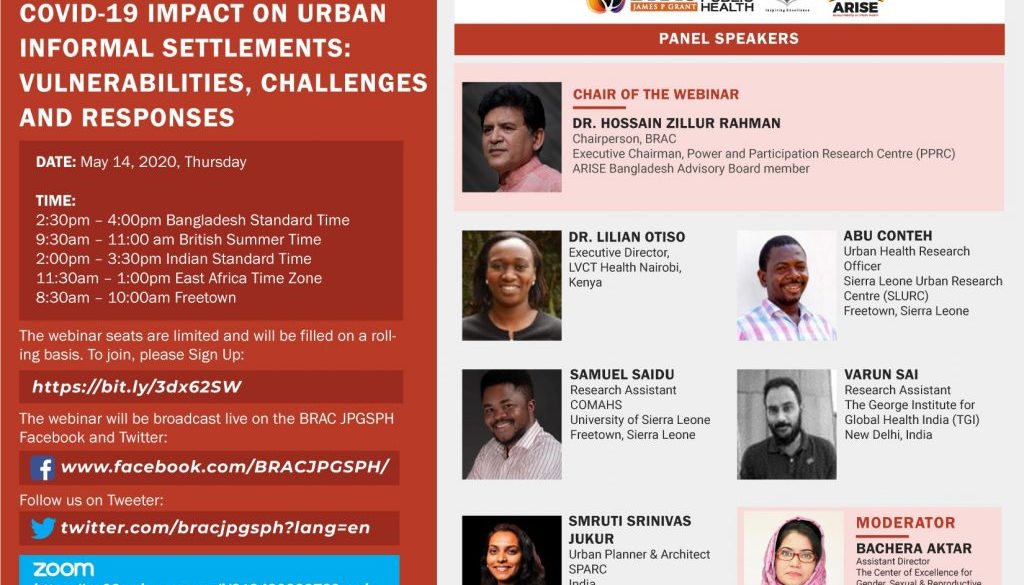Prioritising the most vulnerable in the COVID-19 response in low- and middle-income countries
By Lynda Keeru
COVID-19 has thrown the world into disarray and devastated people, families, communities and systems around the world. It has not spared anyone; it’s gone for migrants, refugees, health care workers – ordinary people trying to make a livelihood for themselves and their families. However, as much as COVID-19 poses a threat to everyone, some groups of people will bear the worst brunt yet; these being the poorer communities. This blog will focus on the urban poor.
The James P Grant School of Public Health, BRAC University hosted a webinar on 14 May 2020 – The Impact of COVID-19 on Urban Informal settlements. Something that stood out from a couple of the presentations was the fact that most of the measures to prevent the spread of the virus and the messages that are disseminated to the public are elitist. They assume people live in the best conditions and are underpinned by ‘one size fits all’ assumptions.
Measures put in place by governments to counter COVID-19
Some of the measures put in place by the governments from the three countries that were featured in the webinar (Kenya, India and Sierra Leone) were very similar. These include hand washing, encouraging people to keep their physical distance, cough etiquette and the wearing of masks. Physical distancing, for example, assumes that everyone has enough space while the reality is that the urban poor often live in overcrowded informal settlements that lack essential services. Hand washing for the recommended 20 seconds using running water is far fetched for this group of people because they live in places that have limited access to water and sanitation.
The urban poor are among those who will be disproportionately affected by the pandemic. During the webinar, a young man asked, “Is there any way that the masks can be distributed for free? Because at my area, they are being sold at a price of 50Ksh ($0.5)), which is seriously affecting the vulnerable.” Dr Lilian Otiso from Kenya explained that many people can genuinely not afford to buy masks because all that their money can do is place some food on the table and many are the times when even this becomes impossible.
Challenges facing the urban poor
Many of the challenges the urban poor face have been heightened. For instance, with a history of poor access to health systems, they now find themselves much further away from these services and with limited or no access to care. Gender based violence is on the increase and crime and violence from law enforcers exacerbated. The pandemic has also aggravated the already horrible state of unemployment with many of the urban poor losing their jobs. Many small and medium businesses have closed down and many livelihoods lost. For instance, due to the nature of the work they do, the waste picking communities from India had no time to prepare or save any money to manage their daily needs during the lockdown. This has left them worried about going hungry and taken a toll on their mental health and physical wellbeing.
Civil society and private sector involvement
As part of the response, many NGOs and CSOs are carrying out relief work and trying to mitigate the suffering of these communities. They also remain the main point of contact when it comes to sourcing information. LCVT Health in Kenya for example has been sending bulk SMS to clients to reinforce the COVID-19, HIV and gender-based violence messages, educating the communities through Community Health Workers, peer educators and mentors. They have also been hosting webinars with youth, informal settlement dwellers and collecting data and credible evidence on COVID-19.
Lessons learned
Some lessons drawn from previous pandemics like Ebola, and even from the early stages of COVID-19 are that in order to mitigate the horrendous effects the virus will have on vulnerable communities there is need to implement a socially equitable approach to the crisis. The response needs to be holistic and all-inclusive with solutions coming from governments, communities, civil society organizations, and the private sector.
Varun Sai and Smruti Jukur from India highlighted that collective bargaining, facilitated through local social networks have largely been the pillar of strength. Abu Conteh and Samuel Saidu from Sierra Leone also drew attention to the fact that community groups are providing leadership for providing social control during emergencies, coordinating distribution of water and food vouchers to vulnerable communities during lockdowns as well as monitoring movement of strangers to avoid spread of disease. These systems and organizations have been especially instrumental for high-risk and vulnerable populations.
Dr Hussein Zillur Rahman from Bangladesh put a lot of emphasis on the importance of accurate, simple communication to avoid misconceptions and myths. He reiterated that a lot of thought needed to be put in the messaging around the pandemic. He challenged the participants to translate and package all the information shared during the webinar into products that can be used to influence policy development. Communications efforts need to be paired with a simplified delivery process.
The speakers highlighted the many lessons drawn especially for use in the event that other pandemics struck in future. Emergency measures must be pro-poor like the provision of water and social protection measures. There is need to plan and develop informal settlements to address health and sanitation priorities and most importantly, utilize data generated from community groups to inform the interventions. Additionally, inclusiveness is paramount for better planning and prevention.
COVID-19 is a shared global challenge and we need a global effort to fight this pandemic and it is important to prioritize the most vulnerable people in the response if we are to change the trajectory of this crisis.

Remote research methods to use during the COVID-19 pandemic - Arise
27/05/2020 @ 09:13
[…] https://video.itu.dk/video/21489832/sarah-pink-digital-ethnography […]